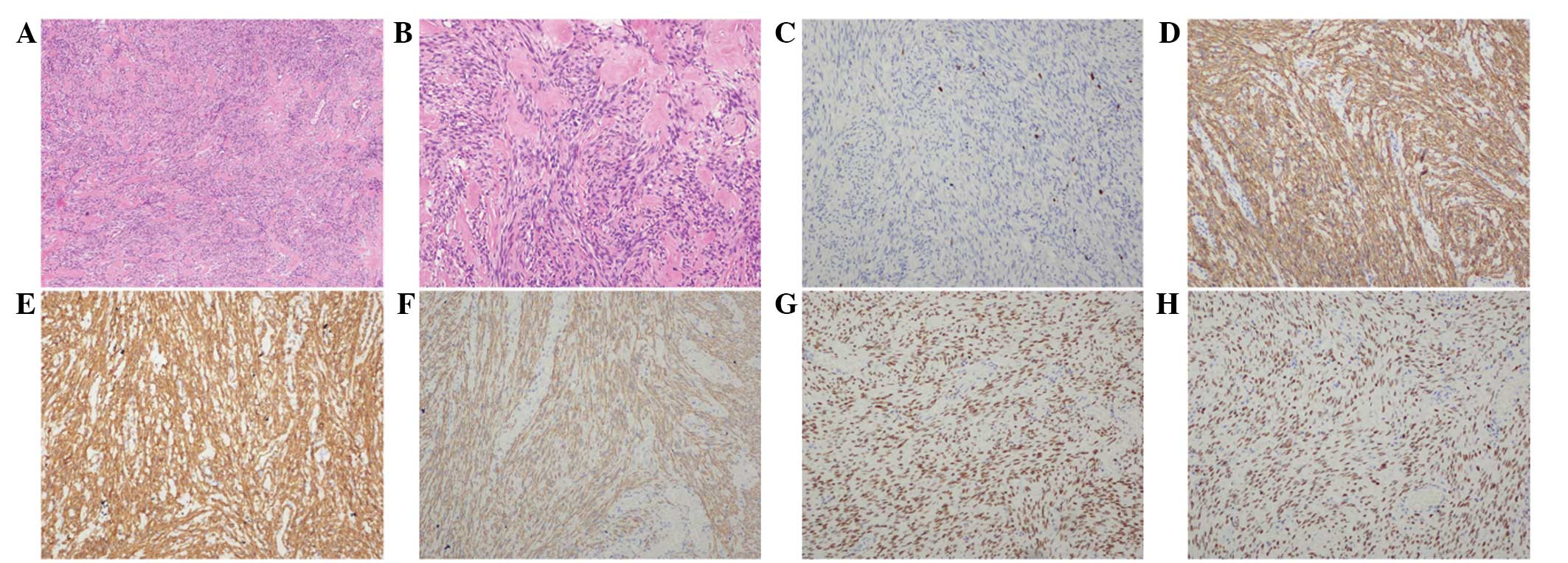|
1
|
Akkersdijk GJ, Flu PK, Giard RW, van Lent
M and Wallenburg HC: Malignant leiomyomatosis peritonealis
disseminata. Am J Obstet Gynecol. 163:591–593. 1990. View Article : Google Scholar : PubMed/NCBI
|
|
2
|
Alaniz Sanchez A and Castañeda Delgado Y:
Disseminated peritoneal leiomyomatosis with malignant degeneration.
A case report. Ginecol Obstet Mex. 62:336–340. 1994.(In Spanish).
PubMed/NCBI
|
|
3
|
Raspagliesi F, Quattrone P, Grosso G,
Cobellis L and Di Re E: Malignant degeneration in leiomyomatosis
peritonealis disseminata. Gynecol Oncol. 61:272–274. 1996.
View Article : Google Scholar : PubMed/NCBI
|
|
4
|
Borsellino G, Zante P and Ciraldo MC:
Diffuse peritoneal leiomyomatosis. A clinical case report. Minerva
Ginecol. 49:53–57. 1997.(In Italian). PubMed/NCBI
|
|
5
|
Yamaguchi T, Imamura Y, Yamamoto T and
Fukuda M: Leiomyomatosis peritonealis disseminata with malignant
change in a man. Pathol Int. 53:179–185. 2003. View Article : Google Scholar : PubMed/NCBI
|
|
6
|
Sharma P, Chaturvedi KU, Gupta R and Nigam
S: Leiomyomatosis peritonealis disseminata with malignant change in
a post-menopausal woman. Gynecol Oncol. 95:742–745. 2004.
View Article : Google Scholar : PubMed/NCBI
|
|
7
|
Yu RS, Wang ZK, Sun JZ and Chen LR:
Computed tomography of pancreatic implantation with malignant
transformation of leiomyomatosis peritonealis disseminata in a man.
Dig Dis Sci. 52:1954–1957. 2007. View Article : Google Scholar : PubMed/NCBI
|
|
8
|
Lamarca M, Rubio P, Andrés P and Rodrigo
C: Leiomyomatosis peritonealis disseminata with malignant
degeneration. A case report. Eur J Gynaecol Oncol. 32:702–704.
2011.
|
|
9
|
Larraín D, Rabischong B, Khoo CK,
Botchorishvili R, Canis M and Mage G: “Iatrogenic” parasitic
myomas: unusual late complication of laparoscopic morcellation
procedures”. J Minim Invasive Gynecol. 17:719–724. 2010. View Article : Google Scholar
|
|
10
|
US Food and Drug Administration.
Laparoscopic uterine power morcellation in hysterectomy and
myomectomy: FDA safety communication. http://www.fda.gov/MedicalDevices/Safety/AlertsandNotices/ucm393576.htm.
Accessed April 17, 2014
|
|
11
|
Willson JR and Peale AR: Multiple
peritoneal leiomyomas associated with a granulosa-cell tumor of the
ovary. Am J Obstet Gynecolo. 64:204–208. 1952.
|
|
12
|
Al-Talib A and Tulandi T: Pathophysiology
and possible iatrogenic cause of leiomyomatosis peritonealis
disseminata. Gynecolo Obstet Invest. 69:239–244. 2010. View Article : Google Scholar
|
|
13
|
Kumar S, Sharma JB, Verma D, Gupta P, Roy
KK and Malhotra N: Disseminated peritoneal leiomyomatosis: an
unusual complication of laparoscopic myomectomy. Arch Gynecol
Obstet. 278:93–95. 2008. View Article : Google Scholar : PubMed/NCBI
|
|
14
|
Fujii S: Experimental approach to
leiomyomatosis peritonealis disseminata - progesterone-induced
smooth muscle-like cells in the subperitoneal nodules produced by
estrogen. Acta Obstet Gynaecol Jpn. 33:671–680. 1981.(In Japanese).
PubMed/NCBI
|
|
15
|
Tavassoli FA and Norris HJ: Peritoneal
leiomyomatosis (leiomyomatosis peritonealis disseminata): a
clinicopathologic study of 20 cases with ultrastructural
observations. Int J Gynecol Pathol. 1:59–74. 1982. View Article : Google Scholar : PubMed/NCBI
|
|
16
|
Hales HA, Peterson CM, Jones KP and Quinn
JD: Leiomyomatosis peritonealis disseminata treated with a
gonadotropin-releasing hormone agonist. A case report. Am J Obstet
Gynecol. 167:515–516. 1992. View Article : Google Scholar : PubMed/NCBI
|
|
17
|
Takeda T, Masuhara K and Kamiura S:
Successful management of a leiomyomatosis peritonealis disseminata
with an aromatase inhibitor. Obstet Gynecol. 112:491–493. 2008.
View Article : Google Scholar : PubMed/NCBI
|
|
18
|
Parente JT, Levy J, Chinea F, Espinosa B
and Brescia MJ: Adjuvant surgical and hormonal treatment of
leiomyomatosis peritonealis disseminata. A case report. J Reprod
Med. 40:468–470. 1995.PubMed/NCBI
|
|
19
|
Bisceglia M, Galliani CA, Pizzolitto S, et
al: Selected case from the Arkadi M. Rywlin International Pathology
Slide series: Leiomyomatosis peritonealis disseminata: report of 3
cases with extensive review of the literature. Adv Anat Pathol.
21:201–215. 2014. View Article : Google Scholar : PubMed/NCBI
|
|
20
|
Sobiczewski P, Bidziński M, Radziszewski
J, Panek G, Olszewski W and Tacikowska M: Disseminated peritoneal
leiomyomatosis - case report and literature review. Ginekol Pol.
75:215–220. 2004.(In Polish). PubMed/NCBI
|
|
21
|
Hoynck van Papendrecht HP and Gratama S:
Leiomyomatosis peritonealis disseminata. Eur J Obstet Gynecol
Reprod Biol. 14:251–259. 1983. View Article : Google Scholar : PubMed/NCBI
|
|
22
|
Buttner A, Bässler R and Theele C:
Pregnancy-associated ectopic decidua (deciduosis) of the greater
omentum. An analysis of 60 biopsies with cases of fibrosing
deciduosis and leiomyomatosis peritonealis disseminata. Pathol Res
Pract. 189:352–359. 1993. View Article : Google Scholar : PubMed/NCBI
|
|
23
|
Heinig J, Neff A, Cirkel U and
Klockenbusch W: Recurrent leiomyomatosis peritonealis disseminata
after hysterectomy and bilateral salpingo-oophorectomy during
combined hormone replacement therapy. Eur J Obstet Gynecol Reprod
Biol. 111:216–218. 2003. View Article : Google Scholar : PubMed/NCBI
|
|
24
|
Ghosh K, Dorigo O, Bristow R and Berek J:
A radical debulking of leiomyomatosis peritonealis disseminata from
a colonic obstruction: a case report and review of the literature.
J Am Coll Surg. 191:212–215. 2000. View Article : Google Scholar : PubMed/NCBI
|
|
25
|
Lin YC, Wei LH, Shun CT, Cheng AL and Hsu
CH: Disseminated peritoneal leiomyomatosis responds to systemic
chemotherapy. Oncology. 76:55–58. 2009. View Article : Google Scholar
|
|
26
|
Valente PT: Leiomyomatosis peritonealis
disseminata. A report of two cases and review of the literature.
Arch Pathol Lab Med. 108:669–672. 1984.PubMed/NCBI
|
|
27
|
Guarch R, Puras A, Ceres R, Isaac MA and
Nogales FF: Ovarian endometriosis and clear cell carcinoma,
leiomyomatosis peritonealis disseminata, and endometrial
adenocarcinoma: an unusual, pathogenetically related association.
Int J Gynecol Pathol. 20:267–270. 2001. View Article : Google Scholar : PubMed/NCBI
|
|
28
|
Haberal A, Kayikcioglu F, Caglar GS and
Cavusoglu D: Leiomyomatosis peritonealis disseminata presenting
with intravascular extension and coexisting with endometriosis: a
case report. J Reprod Med. 52:422–424. 2007.PubMed/NCBI
|
















